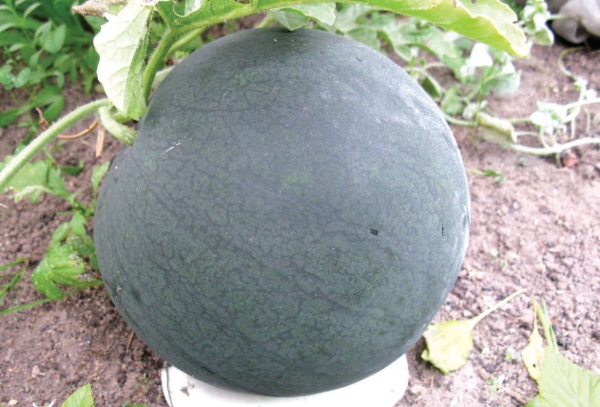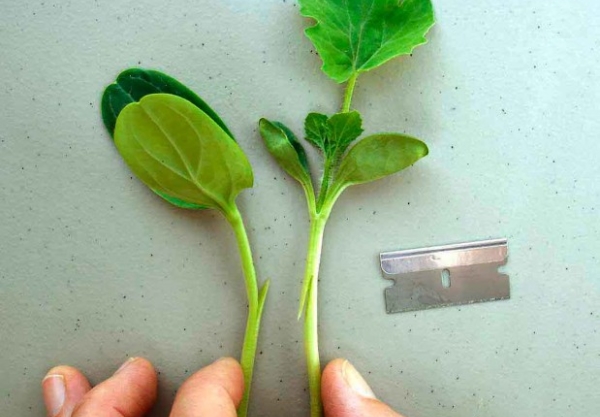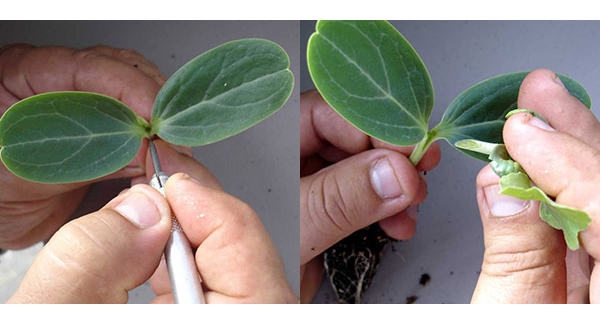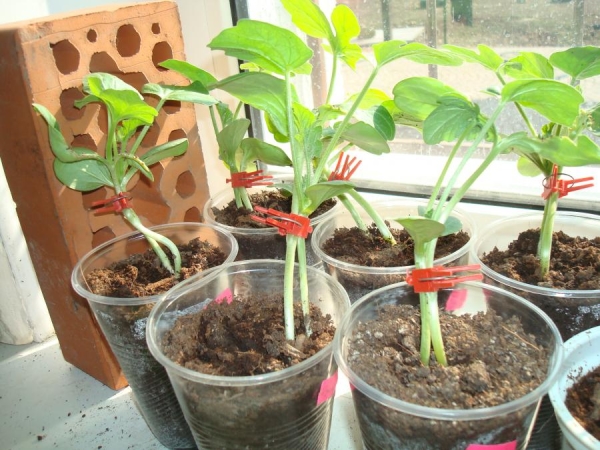Inoculation of heat-loving southern cultures to hardy related plants - a popular direction of breeding in horticulture and horticulture, which finds interesting use in the amateur cultivation of melons in the middle lane. Experiencing gardeners get a good harvest, grafting a varietal watermelon on an ordinary bottle gourd. Consider the existing vaccination options in stages, so as not to miss important technological details.
Table of contents
For what purposes is the vaccine used?
A heat-loving watermelon requires that the soil temperature does not drop below 15 ° C during the summer. The branched stem of a watermelon grown from seedlings in a natural way (at its root) constantly needs warm ground.
A well-developed bottle gourd root system is capable of delivering nutrients even at a ground temperature of 7 - 10 ° C.
This allows the grafted berries to form a strong lash, with a large number of successfully ripening ovary.
Grafted watermelons have larger fruit.. This is due to the fact that the usual stops the growth of fruits in the absence of sunny weather for 7 to 10 days (which is quite often our summer).
In a traditional watermelon, when the weather is cloudy, ripening will begin immediately, and the grafted will continue to grow.
Besides, bottle gourd roots, unlike watermelon, are practically not susceptible to fusarium - A disease that often kills plants.

Is it possible to vaccinate on lagenariya?
You can graft watermelon on pumpkins of different varieties. But the best option for growing strong plants and successful maturation of large varieties in the middle zone of the Russian Federation, is a pumpkin bottle (Indian cucumber, pot, lagenaria).
In addition to cooking, fully ripened lagenaria pumpkins are used to make dishes, decorative items, amulets, and folklore tools.
In the middle lane, lagenaria is usually grown in a seedling way, as is striped berry. For vaccination on Lagenaria can use varieties Chill, Astrakhan, Kherson, or early - Chernousk, Korean other.

Types of watermelon grafting on a pumpkin
To plant a watermelon on lagenariya is easy. For these two plants grow together, a small contact surface is sufficient.
Let us consider in detail the possible options:
- reed (the most common method);
- to the center;
- rapprochement.
The choice of the method of vaccination is a matter of personal preference of the gardener, confirmed by individual experience.
Vaccinating watermelon on a pumpkin (lagenaria):
Tongue
Saplings of a stock and a scion for this method choose with 2 - 3 true leaves. The method has excellent survival rate, and can be recommended even for beginners.
On the stalk of a pumpkin, at a distance of 5 - 7 mm below the cotyledonous leaves, with a scalpel we make an oblique cut in the direction from top to bottom. Notch length 5 - 6 mm, depth - 2/3 of the stem.
The stalk of a watermelon, at the same height, is cut to the contrary - from the bottom up. The depth and length of the second cut is the same.
Planted interconnected plants in one large glass (volume 0.5 - 0.8 l), immediately put it in the lit place.
After 5 days, the stem of the watermelon must be squeezed below the level of vaccination, the plant begins to feed from the roots of the pumpkin. After another 5 days, cut off the stalk of a watermelon and cut off the top of the lagenaria.
Once the place has healed, the foil is removed.. Finish - a striped berry sapling grafted onto more powerful roots.
For seedlings, use a light, sufficiently nutritious mixture.For example: nutrient substrate and coconut chips, the ratio of 1/3. It is desirable to disinfect the mixture.
This will allow the seedlings to avoid fungal diseases, including dangerous for the “black leg” pumpkin family.

To center (split)
We take a pumpkin sapling with a barely crept leaf, and a watermelon sapling with 2 - 3 true leaves.
Using an acute scalpel, with an oblique incision directed toward the center, we cut off the sprout of lagenaria just above the cotyledon leaves. Then slightly extend the incision by 1 - 1.5 mm.
At a water-melon sapling we cut off a top with a growth point at an acute angle. The resulting wedge with 2 - 3 true leaves of watermelon tightly inserted into the center of the rootstock, in place of the cut point of growth.
Gently fix the place of vaccination (split) with food foil or graft clip.
The grafted seedling is planted in a plastic container with a volume of 0.5 - 0.8 l, be sure to cover with a plastic bottle with a cut off bottom and a twisted cork. Foil (or clip) can be removed as soon as the place heals.

Rapprochement
We take seedlings of a stock and a scion with 2 true leaves, we plant them at the same level, as close as possible to each other,in the din a big glass.
On the inner side of the stems, 5 - 7 mm above the cotyledon leaves, cut off the skin with a sharp knife. Tightly connect the plants, fix the inoculation with foil.
After 5 - 7 days, the stem of the watermelon must be squeezed below the level of vaccination.. The plant begins to feed on the roots of the pumpkin, and the root of the watermelon will gradually wither.
When planting in the open ground pumpkin sprout can be cut off completely.
Vaccination of watermelon on lagenarium approaching:
Features of the procedure
To enhance the properties of the grafted plant, breeders traditionally use a younger stock. Accordingly, the graft should be older.
In our case watermelon seedlings should be planted at least three days earlier than lagenaria seedlings.
Before grafting, melon seedlings can be grown in small cups of 100 - 200 ml. After grafting, the plant will need a significantly larger amount of the nutrient mixture.
After grafting, the plant is immediately transplanted into a larger volume glass (0.5 - 0.8 l).
To increase the yield of grafted plants, all leaves of pumpkin (rootstock) is desirable to remove. This stimulates the metabolic processes of the combined plants, and the result is a good harvest.
Another feature of grafted watermelon is the need for more territory.. When planting in open ground, each seedling is allocated up to 8 square meters. m of usable area.

Graft Plant Care
To reduce the vulnerability of grafted seedlings, after vaccination is especially important to ensure a stable temperature.
Comfortable development of seedlings, without extrusion, occurs at air temperatures from 25 ° C and above. Seedlings are kept on the solar window, if necessary - provide heating.
After grafting, the plants are covered with a plastic bottle with a cut-off bottom. The stopper is left swirling. After 5 days, the seedlings begin to air systematically.
The cork is unscrewed for 20-30 minutes on sunny days, gradually increasing the time, and increasing ventilation.After two weeks, the plant will get strong enough, the bottle can be removed altogether.
In early June (depending on the zone), it's time to plant melons in the ground - Grafted watermelons develop much more actively than usual.
The bed for them is selected in a well-lit, sunny place. The solar plot prepared by the method of organic farming will successfully adapt the grafted watermelons.
Pamper your family with a great hand-grown watermelon crop!
